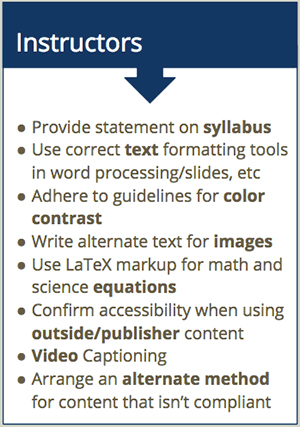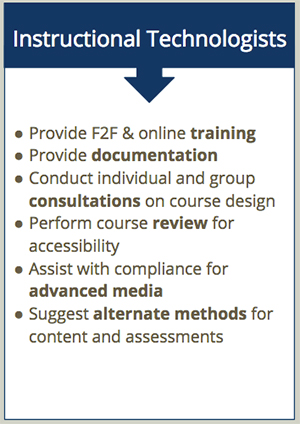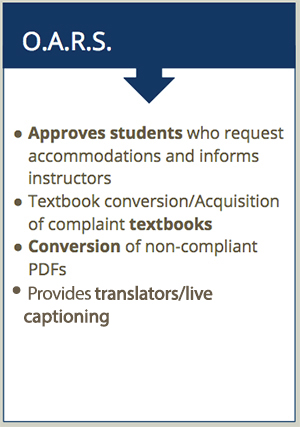What is Accessibility?
Under federal law, Section 504 of the Rehabilitation Act and Titles I and II of the Americans with Disabilities Act (ADA) are the applicable mandates for the university’s efforts to provide electronic accessibility to persons with disabilities.
From Section 504 of the Rehabilitation Act of 1973:
no otherwise qualified handicapped individual in the United States. . . shall, solely by reason of. . . handicap, be excluded from the participation in, be denied the benefits of, or be subjected to discrimination under, any program or activity receiving Federal financial assistance.
According to UNCG’s OARS office, there are seven general categories for disability related services:

Why Do We Care? Universal Design for Learning (UDL)
- According to the National Center for Education Statistics (2016):
- The number of undergraduates in postsecondary education in the U.S. with a disability increased from 6% in 1999 to 11% in 2012, and there are almost 2 million disabled students nationwide.
- Students with disabilities are significantly less likely to earn a bachelor’s degree- 31% of disabled students earn a bachelor’s in eight years compared to 51.2% of non-disabled students, even though in 2015 the National Council on Disability reported that disabled students are attending higher education at roughly the same rate as non-disabled students.
- 5% of UNCG students have some form of learning disability and/or 29% have an attention deficit disorder; hearing impairments comprise 5% of our population, while 2% are visually impaired, 4% are mobility impaired, 14% have medical impairments, and 11% other health impaired. (According to OARS office)
- This is a large potential population to tap into for online courses.
- It’s the LAW.
However, accessibility is really about access, and so the conversation will be better served to focus on Universal Design for Learning (UDL), where accessibility for disabled students is one part of the larger effort toward making online content more accessible for all users. As described in Tobin and Behling (2018), Universal Design for Learning is “an approach to the creation of learning experiences and interactions that incorporates multiple means of:
- engaging with content and people
- representing information, and
- expressing skills and knowledge” (p. 2)
It can help your understanding of UDL to consider curb cutouts, escalators, and extra wide entryways. All these things accommodate someone with a wheelchair, but they are also helpful for those with strollers, large items such as luggage, shopping carts, and moving furniture. The same concept can apply in learning. Universal Design for Learning aims to reduce learning barriers for everyone, including but not limited to those with specific disabilities.
Who is Responsible for Accessibility Compliance?



Instructors should be able to provide a compliance statement on their syllabi (examples of which can be provided), use correct formatting/markup for text, adhere to guidelines for color contrast, write alternate text for images, and use correct markup language for equations. In addition, instructors are responsible for confirming accessibility compliance when using outside/publisher content and arranging an alternate method for content that cannot be made compliant. Finally, instructors complete the process for video captioning, with assistance as needed from the ITC.
Instructional Technology Consultants provide both face-to-face and online training and documentation related to accessibility. Additionally, the ITC can perform an accessibility check on course content, assist with compliance for advanced media, and suggest alternate methods of presentation/assessment for content that cannot be made accessible.
The Office of Accessibility Resources and Services (OARS) approves students who request accommodations and informs instructors. The OARS office will also facilitate the acquisition of compliant textbooks and P.D.F. files, and work with instructors to arrange for translators or live captioning for a class.
Resources:
- U.S. Department of Education, National Center for Education Statistics. (2016). Digest of Education Statistics, 2014 (NCES 2016-006), Table 311.10.
- Tobin, T.J., & Behling, K. T. (2018). Reach Everyone, Teach Everyone: Universal Design for Learning in Higher Education, Morgantown, WV: West Virginia University Press.





